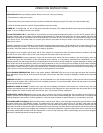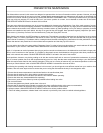
WARNING:
Inspection, testing and repair of electrical equipment should only be performed by a qualified service technician.
Many of the tests require that the unit have power to it and live electrical components be exposed. USE EXTREME CAUTION
WHEN TESTING THE MACHINE.
Problem: Door drops hard and will not stay closed.
1. The door spring is broken. Replace as required.
2. The door hinge is bent. Replace as required.
Problem: Water flooding from the machine.
1. The drain valve is not operating. Verify the wiring of the valve motor. If it is correct then replace the valve.
2. Incoming water pressure is too high. Verify that the incoming water is at 20A5 PSI flow pressure. If not, adjust as required.
3. Timer motor shorted out during the rinse/fill cycle or has a defective microswitch. Verify that the timer operates and that it and the fill
microswitch are wired correctly. If either component is defective, replace them.
Problem: Water begins draining from the machine at the beginning of the cycle.
1. Drain valve stuck in the open position. Remove the valve assembly; correct or replace the valve.
2. The drain valve is not installed correctly and water is leaking by the connections. Correct by tightening the connections.
3. The drain valve is damaged. Replace the drain valve.
Problem: Water leaks from the vacuum breaker.
1. Vacuum breaker plunger or the seat is deformed. Repair using parts from a vacuum breaker repair kit.
2. Lime or scale build-up in the vacuum breaker. Open the vacuum breaker and remove the plunger and the seat. Use a deliming solu
-
tion to dissolve the lime and scale. Reassemble the vacuum breaker when finished.
3. There may be an obstruction preventing the vacuum breaker from properly seating. Remove the obstruction.
TROUBLESHOOTING SECTION (CONTINUED)
13


















